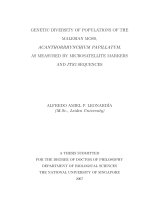Genetic diversity of ivory shell (babylonia ar
Bạn đang xem bản rút gọn của tài liệu. Xem và tải ngay bản đầy đủ của tài liệu tại đây (181.43 KB, 1 trang )
Food Control 48 (2015) 108e116
Contents lists available at ScienceDirect
Food Control
journal homepage: www.elsevier.com/locate/foodcont
Genetic diversity of ivory shell (Babylonia areolata) in Taiwan and
identification of species using DNA-based assays
Tsai-Hsin Chiu a, *, Ching-Wen Kuo a, Hui-Chiu Lin b, Ding-Shi Huang b, Po-Long Wu c
a
Deperment of Food Science, National PengHu University of Science and Technology, Taiwan
Penghu Marine Biology Research Center, Fisheries Research Institute, COA, EY, Taiwan
c
Environment and Biotechnology Department, Refining and Manufacturing Research Institute, CPC Corporation, Chiayi, Taiwan
b
a r t i c l e i n f o
a b s t r a c t
Article history:
Received 27 November 2013
Received in revised form
7 February 2014
Accepted 7 May 2014
Available online 29 May 2014
For better traceability of seafood products in Taiwan, we need to effectively test product quality during
the processes of identification of seafood species. The aim of this study was to analyse gene diversity and
the methods of identification of high-value seafood, ivory shell (Babylonia areolata), on the Penghu Island
in Taiwan using molecular marker technology and to build a relevant molecular database. Thirty-three
samples of B. areolata and the samples of 5 other Babylonia species, including Babylonia feicheni, Babylonia spirata spirata, Babylonia perforata and Babylonia formosae formosae, from cultivation and from the
wild were tested using the inter-simple sequence repeat (ISSR) method, mitochondrial DNA analysis,
PCR-single-strand conformation polymorphism (PCR-SSCP) and PCR-denaturing gradient gel electrophoresis (PCR-DGGE). The results showed that the primers ISSR3, ISSR7 and ISSR13 of the ISSR method
and cytochrome C oxidase subunit 1 (coxI) gene analysis have a good discriminatory power in interspecies and intra-species tests. In conclusion, ISSR, PCR-DGGE and PCR-SSCP with coxI analysis can be
used for the screening and identification of B. areolata species. Furthermore, these molecular methods
could be useful for the identification of other types of seafood.
© 2014 Elsevier Ltd. All rights reserved.
Keywords:
Cytochrome C oxidase subunit 1
Inter-simple sequence repeat method
Babylonia areolata
1. Introduction
The globalization of the seafood industry has allowed many
countries to import or export several local species to countries
around the world. Because of an increasingly complex supply chain,
information about fish is often unclear, insufficient, confusing or
misleading to buyers. After seafood is imported, it often makes
many more stops before reaching the consumer, thus causing difficulties with tracking. Many fishery products are processed (eviscerated, beheaded, skinned, filleted, marinated, salted, smoked and
canned) before delivery to buyers, and this modification makes it
difficult to identify the species in some circumstances (Mafra,
Ferreira, & Oliveira, 2008). Moreover, the growing demand for
seafood products has given rise to deceptive practices such as
misbranding of fish species. The seafood fraud involving substitution or mislabelling of high-end market fish with lower-priced
species is common (Rasmussen, Morrissey, & Hebert, 2009).
Therefore, a study of species identification was conducted here,
prompted in part by the growing concern in the area of food safety
* Corresponding author. Tel.: þ886 69264115x3826.
E-mail address: (T.-H. Chiu).
/>0956-7135/© 2014 Elsevier Ltd. All rights reserved.
regarding seafood fraud. After simple inspection of an aquatic
product, it is not always possible to determine that misbranding has
occurred. Processing often removes or damages diagnostic characteristics crucial for species identification by conventional taxonomic methods. Therefore, traditional morphological methods are
often insufficient for distinguishing species (Handy et al., 2011).
DNA is more informative than proteins and can be easily
extracted from small traces of organic material (Hellberg &
Morrisey, 2011). PCR-based methods are extremely sensitive,
often more rapid than other techniques and are widely used in the
fishery industry (Rasmussen & Morrissey, 2008). Numerous DNAbased detection methods have been used for the identification of
seafood species and characterization of different types of animal
and plant products. These include PCR sequencing; discontinuous
molecular markers such as random amplified polymorphic DNA,
amplified fragment length polymorphisms and their variants [i.e.
inter-simple sequence repeat (ISSR), sequence-specific amplification polymorphism and selective amplification of microsatellite
polymorphic loci]; and single-stranded conformation polymorphism (SSCP) (Hellberg & Morrisey, 2011; Teletchea, 2009;
Galimberti et al., 2013). In addition, ISSR and SSCP do not require
prior knowledge of DNA sequence information. The ISSR technology is cheaper, simpler and more rapid than the other methods and









